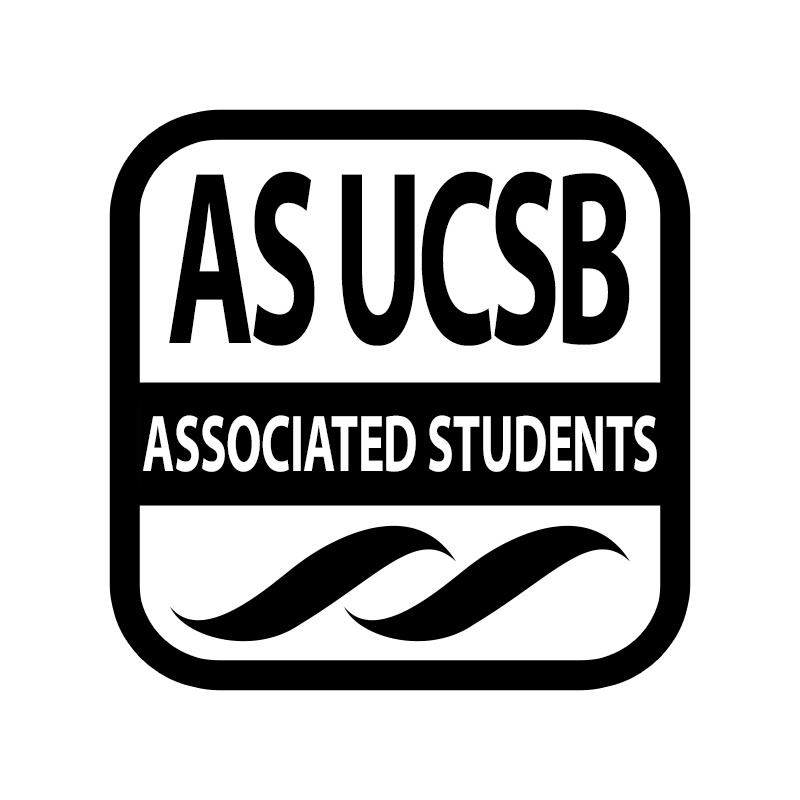INTRODUCTION
The Living History Project is a branch of Associated Students that tracks, archives, and narrates the history of student activism at UCSB. It traces the origins of organizations such as the Black Students Union (BSU), El Congreso, A.S. Queer Commission, A.S. Women’s Commission, and others that are part of UCSB student’s activist tradition, a tradition that has brought about significant and far reaching changes at UCSB and beyond. It chronicles how they were developed and integrated into our community. This project shifts the historical point of view towards students and shows how they enacted change on and off campus. The Living History Project amplifies the voices of the students in the face of corruption, injustice, and inequity and will continue to serve as a platform as current social and political issues arise.

THIS YEAR’S RESEARCH AS POSTED ON FACEBOOK
September 26: UCSB can trace its origins all the way to the beginning of the 20th century, with the founding of the Anna S.C. Blake School for Girls. The school went through a couple reinventions until it was finally turned over to the University of California system in 1944. The school was then moved from the Riviera and the Mesa in Santa Barbara to an old WWII marine base on Goleta Point.
[Image retrieved from https://www.ucsb.edu/about/history]



October 1: September 1969, Black Studies opened with an initial Fall enrollment of 83 students [predominantly Black]. Enrollment in Black Studies courses reached 428 at the end of the first year of existence. The creation of the Center for Black Studies Research and the Black Studies Library followed soon after.
[Image retrieved from https://www.blackstudies.ucsb.edu/about]

October 14: On October 14, 1968, 12 students from the Black Student Union barricaded themselves inside of the Computer Center in North Hall to demand justice for Black students at UCSB. They entered the building at 6:30 AM, and by 10 AM, had amassed a crowd of about 1,000 people in the courtyard, although not all of them were allies. The North Hall Takeover was successful in getting 7 of BSU’s 8 demands granted, but the demand to fire racist employees from Physical Activities was ignored despite being their first demand. This victory paved the way for not only Black Studies, but also Chicanx Studies, Asian American Studies, and Feminist Studies.
[Lisa Butterworth, Ted Anderson. (October 15, 1968). Blacks Take North Hall, Sixteen Control Computer Center Throughout Day. 𝘌𝘭 𝘎𝘢𝘶𝘤𝘩𝘰. Retrieved from https://www.alexandria.ucsb.edu/downloads/bg257g26f]

October 16: On October 3-4, 2011, students and community demonstrators continued to show support for the Occupy Santa Barbara movement in De La Guerra Plaza throughout the evening. Although given warnings of arrests by the police, students and protesters continued their work. Eight people were arrested and later released from the Santa Barbara County Jail.
[Garcia, Amanda. (October 5, 2011) Occupy Santa Barbara Continues Despite Police Warnings. 𝘛𝘩𝘦 𝘉𝘰𝘵𝘵𝘰𝘮 𝘓𝘪𝘯𝘦. Retrieved from https://thebottomline.as.ucsb.edu/…/occupy-santa…]

October 18: The Associated Students Food Bank originally started in 2011, thanks to then AS President, Paul Monge-Rodriguez. He had heard from Financial Aid and EOP that students were skipping meals to save money for their tuition and books. AS then conducted a survey that revealed just how prevalent hunger security was on campus and that prompted action. The team of about 6 students opened for the first time in April of 2011 and was only open 2 days of the week. Now, the Food Bank is open Monday, Wednesday, Thursday, and Friday from 9 AM to 6:30 PM. They have also recently moved to the second floor of the UCen, across from Subway, which has increased space and accessibility. Thanks to these students’ dedication to bettering student life, the Food Bank has become a staple of the campus.
[Source: https://www.youtube.com/watch?reload=9&v=5cB8Ftf5OaI…]

October 22: On October 21-22, 1998 there was a UC-wide walkout in response to Prop 209, which prohibited universities from considering race, sex, or ethnicity when admitting students. It was further fueled by the recent attacks on ethnic studies. Approximately 500 students and staff members participated. The days consisted of workshops, public speakers, and a march through campus.
[Anderson, Ted & Butterworth, Lisa. (October 22, 1998) First Day of Demonstration Includes Student Walkout, Campus Activities. 𝘋𝘢𝘪𝘭𝘺 𝘕𝘦𝘹𝘶𝘴. Retrieved from https://www.alexandria.ucsb.edu/downloads/mk61rj069]

October 29: As #FilipinoAmericanHistoryMonth comes to an end, we wanted to highlight the presence of Fil-Ams on our campus! In 1992, a group of 90 students, both Filipino and non-Filipino, got together to produce the first-ever Pilipino Cultural Night. The performance consists of an original play, traditional and modern dance, and song; furthermore, each aspect is taught and created by students. The first-ever @ucsbpcn opened on May 23, 1992, to a sold-out Campbell Hall, and is the longest-running student-run performance. PCN continues to be a staple of the Filipino American experience here at UCSB, and it will be celebrating its 29th performance this year!
[Image retrieved from: https://www.youtube.com/watch?v=7AOpa6-xJas]
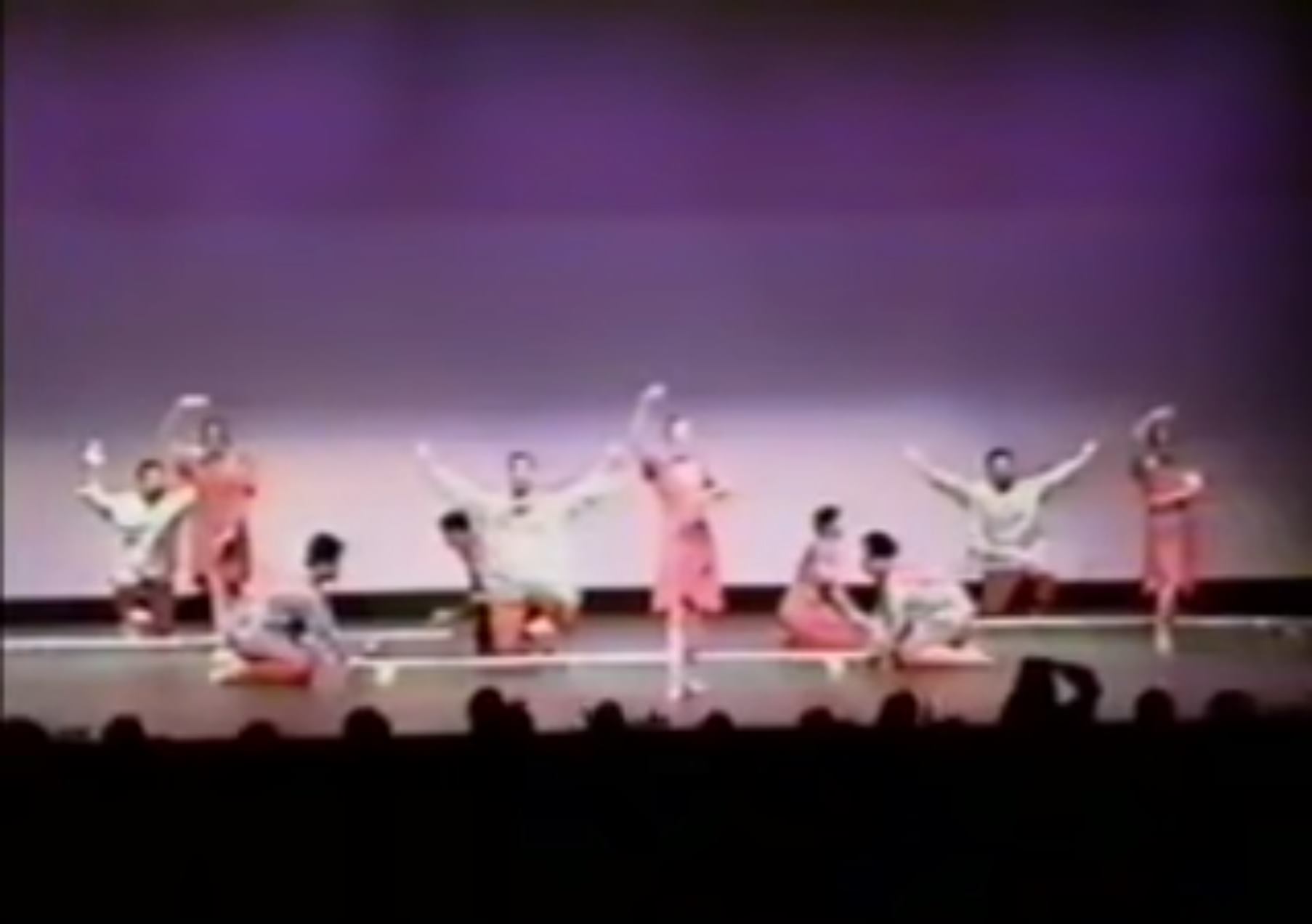
October 31: In 1987, a citizens committee called “Red Alert” was initiated in Isla Vista. This committee was responding to increased sexual abuse of women during Isla Vista’s Halloween celebrations. Throughout the night, they assisted intoxicated people, walked women home, and educated folks on why they should not grab/pinch women.
[Ray, Michelle. (November 2, 1987) Red Alert Works to Promote Safe, Fun Halloween. 𝘋𝘢𝘪𝘭𝘺 𝘕𝘦𝘹𝘶𝘴. Retrieved from https://alexandria.ucsb.edu/downloads/3197xn40m]

November 5: Fall 1967, Anti-Vietnam war activism constituted the majority of student political activity at UCSB. Small groups of students, among them the Student Peace Committee, organized a series of non-violent demonstrations that included picketing induction centers and the ROTC building, counseling student draft resisters, collecting signatures against the war, and sponsoring silent vigils and campus speakers. Anti-war activists, though few in numbers, succeeded in getting the Academic Senate to review the academic credibility of the ROTC program and motivated the Associated Student Council and select members of the faculty to take a public position against the war.
[(“Are You In Favor Of Peace In Vietnam,” University of California, Santa Barbara, Student Organizations Collection, BOX 4). University of California, Santa Barbara, Associated Students Records. UARCH 101. Department of Special Collections, UC Santa Barbara Library, University of California, Santa Barbara]

November 11: November 11, 1998- Queer Student Union and A.S. State-wide Affairs Organizing Director, Sergio Morales, and A.S. Student Advocate Rodney Clara organize protest of UCSB blood drives. Citing the blood bank as a violation of the university system’s anti-discrimination policy. The goal at this point was to continue to put pressure on the university and bring a lawsuit to bar blood drives on the nine UC campuses until the wording on the questionnaire is changed to something that does not stigmatize homosexual activity.
[Simons, Eric. (November 6, 1998) Perceived Discriminatory Screening Triggers Protesting of Blood Drive. 𝘋𝘢𝘪𝘭𝘺 𝘕𝘦𝘹𝘶𝘴. Retrieved from https://alexandria.ucsb.edu/downloads/4j03d1084]

November 18: On November 18, 1968, Chicanx students from UMAS (United Mexican American Students) released a statement criticizing Santa Barbara’s annual “Fiesta” festival. Fiesta is based on remembering the “Good Old Spanish Days,” and is a weekend of food, music, and commodifying Spanish culture and traditions. Students from UMAS viewed this event as paternalistic, degrading, and erasing of the influence that Mexican and Native American communities had on Santa Barbara culture. It also never addressed the discrimination that Mexican-Americans faced at the time. UMAS member, Joseph Navarro, was quoted saying: “If Anglo-Americans accept their (Mexican-Americans’) art and culture, why have they not accepted the people?” The students recommended that the festival be turned over into the hands of Mexican-Americans in Santa Barbara. Fiesta continues to be held annually during the month of August.
[Brinton, Ruth. (November 18, 1968) Chicanos Blast S.B.’s ‘Fiesta;’ Labeled Paternalistic, Degrading. 𝘌𝘭 𝘎𝘢𝘶𝘤𝘩𝘰. Retrieved from https://www.alexandria.ucsb.edu/downloads/dv13zv32x]
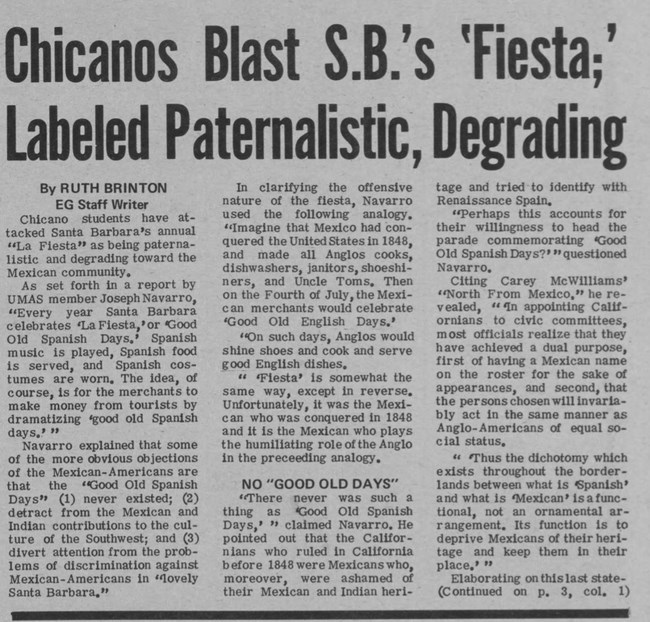
January 6: In 1970, #50YearsAgo, around 250 people marched onto Stearn’s Wharf and sat to occupy the space as a form of protest against offshore drilling? With the Santa Barbara Oil Spill happening just the year before, the people were outraged at the presence of oil. They pushed past the police to enter the wharf, and the rest of the day was spent listening to speeches about how politicians have failed to keep their promises of protecting the environment. Everyone then sat at the entrance of the wharf, allowing cars to leave but not enter. This would not be the only wharf-in that would happen throughout the year. Oil rigs are still visible from Stearn’s Wharf today.
[Kessler, Denise and Jeff Probst. (January 29, 1970). Wharf-in at Stearns. 𝘋𝘢𝘪𝘭𝘺 𝘕𝘦𝘹𝘶𝘴. Retrieved from https://www.alexandria.ucsb.edu/downloads/rr171z35d]
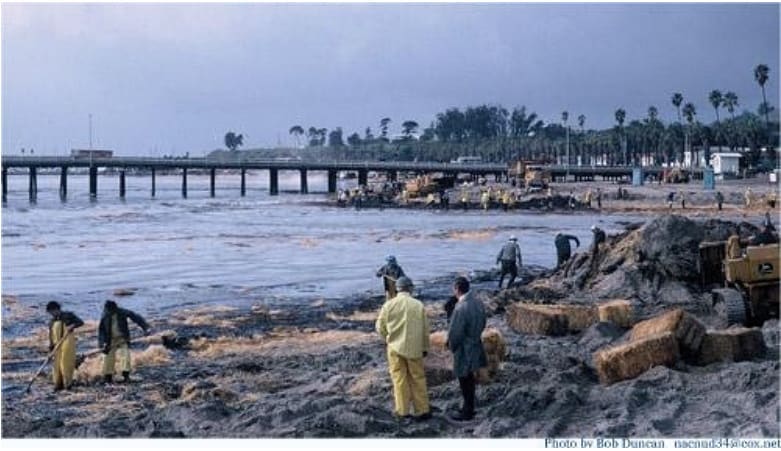
January 7: In 1968, on Finals Week of Fall Quarter, 10 students participated in a sit-in against Dow Chemical Company who were manufacturing napalm for chemical warfare during the Vietnam War. The company was on campus to recruit workers from UCSB. 9 of the students were reprimanded, since one of them had to leave UCSB due to health reasons. The sanctions ranged from warnings to suspension due to the issue of “censure.” UCSB administration decided to sanction these students because they were imposing on other students’ rights to visit the recruiter, but the students claimed that that was not they were doing. Instead, they wanted to be a presence that let students question their choice to join Dow Chemical, but never prevented them from entering the room.
[Hanauer, Gary and Rascati, Wayne. (January 8, 1968). Nine Students Reprimanded for Dow Sit-In. 𝘌𝘭 𝘎𝘢𝘶𝘤𝘩𝘰. Retrieved from https://www.alexandria.ucsb.edu/downloads/4q77fs42s]

January 20: On January 13, 1967, around 2000 people rallied together at the Ortega Commons Free Speech area in response to Ronald Reagan’s recent budget cuts against State schools. The budget for the schools would decrease by 85 million dollars, and tuition would be raised to accommodate for this change. Students from UCs and CSUs got together to organize this anti-tuition rally, especially because the schools were hoping to be granted more money due to rising populations and demand. At the rally, there were mixed feelings among the students, who were mostly upset at the fact that people only show up when it starts to affect them individually. This happened in the midst of student unrest in reaction to the Vietnam War.
[Chenery, Theresa. (January 16, 1967). Mass Opposition to Tuition Shown. 𝘌𝘭 𝘎𝘢𝘶𝘤𝘩𝘰. Retrieved from https://www.alexandria.ucsb.edu/downloads/j67314844]
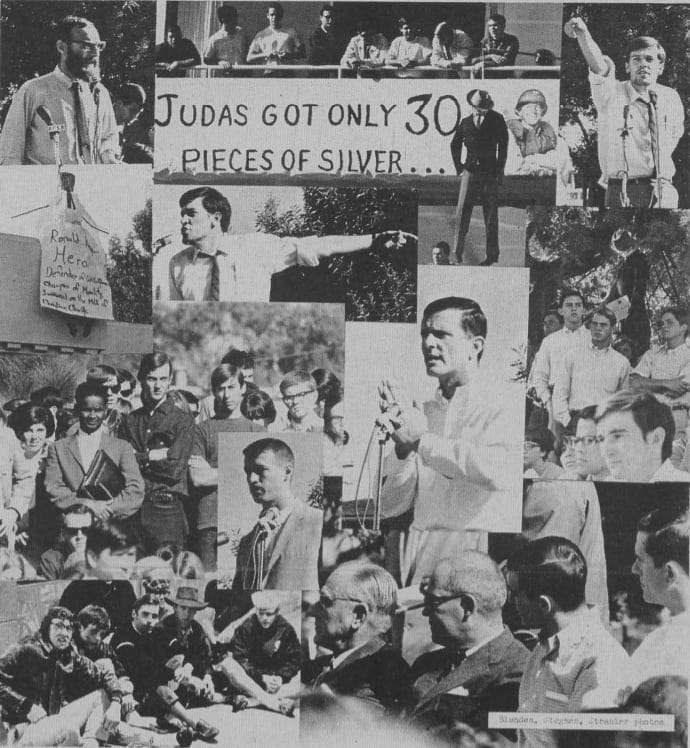
January 22: In late January/early February of 1968, students came together to form United Mexican American Students (UMAS). This is one of the earliest instances of Chicanx student organizing at the UCSB campus. One of their first achievements was creating a program that would recruit Mexican American high schoolers to apply to UCSB. They wanted to reach out the students because they knew they would not respond to white recruiters that they could not relate to. They reached out mainly to students in Carpinteria.
[Bettinger, Jim. (January 24, 1968). Mexican-American Students Attempt Unity. 𝘌𝘭 𝘎𝘢𝘶𝘤𝘩𝘰. Retrieved from https://www.alexandria.ucsb.edu/downloads/dv13zv29m] .


January 30: This was the first page of 𝘌𝘭 𝘎𝘢𝘶𝘤𝘩𝘰 on January 22, 1970. It was a call for a rally at Cheadle Hall on January 28 to demand an open hearing for Bill Allen, an Assistant Professor in the Anthropology department. He was being fired at the end of the academic year for reasons such as insufficient research and not showing up to class on time. Many students felt that his firing was wrong, given that he had published works in the making, and that it was instead fueled by the administration’s desire to push all leftists out. Bill Allen worked very closely with his students, was open about his anti-authoritarian views, and was frequently labelled as a “radical.” Around 1000 students gathered at Cheadle Hall on January 28th to voice their support, but things quickly turned violent when the Dean of Men, Robert Evans, hit a student with his bullhorn. This prompted the police to charge the crowd, and they assaulted 3 students. They were quoted saying that there was no one gave them the order to charge, they just did. Bill Allen was still not given an open hearing.
[Kessler, Denise, Jeff Probst, and Becca Wilson. (January 30, 1970). Campus Cops Charge Crowd of 1,000 Students. 𝘌𝘭 𝘎𝘢𝘶𝘤𝘩𝘰. Retrieved from https://www.alexandria.ucsb.edu/downloads/n296wz986; Image retrieved from https://www.alexandria.ucsb.edu/downloads/9306t039p]

February 19: Around 40 students pledged to a hunger strike until the UCSB administration took action to combat institutional racism and increase ethnic diversity on campus. Students from all ethnicities banded together to come up with a demands list that included the hiring of more diverse faculty, an ethnic studies requirement to graduate, and implementation of more ethnic studies departments, specifically the Asian American Studies Department and a push for a Native American Studies program. The hunger strike was called off 12 days later because students’ health were in danger and the administration agreed to negotiations. Due to lack of adequate response from the administration, the students continued to hunger strike and occupy computer centers, like North Hall, in April. The students would eventually become victorious in establishing an ethnic studies requirement and with the hiring of multiple diverse faculty.
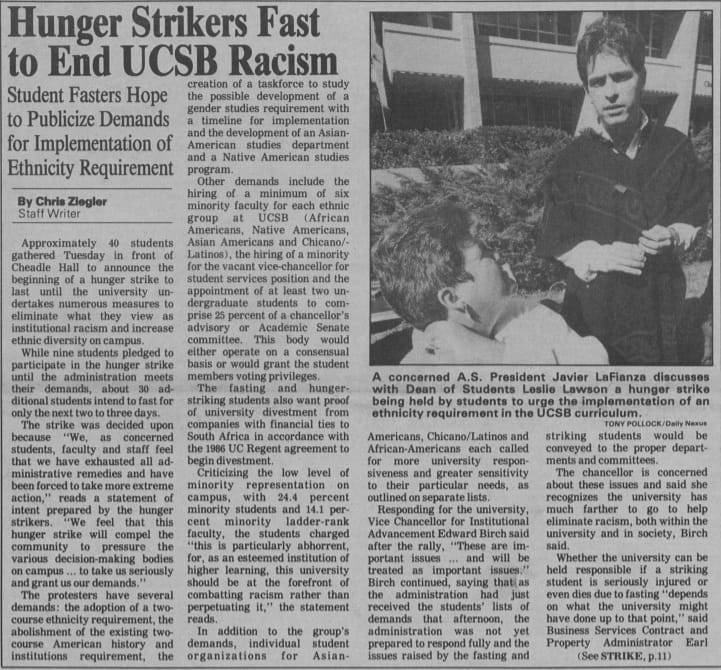
February 21: A little over a week after civil rights leader Dr. Martin Luther King Jr. was assassinated, the Santa Barbara community came together and marched through State Street in commemoration of his life. Around 1500 people from all walks of life gathered together for the march, and about 100 of them were UCSB students. The march happened during Good Friday, which some people thought was fitting, but some were mildly upset by it. Everyone gathered in De La Guerra Plaza, where speakers such as UCSB’s Dr. Homer Swander talked about the necessity for Santa Barbara to increase its educational and job opportunities for people of color and especially Black people. [Wilson, Becca and Dave Court. (April 15, 1968). Santa Barbarans March for King. 𝘌𝘭 𝘎𝘢𝘶𝘤𝘩𝘰. Retrieved from https://www.alexandria.ucsb.edu/downloads/hx11xg358]

February 26: On March 2, 1984, AS Program Board put on an event called Air Jam. This was a lip syncing/impersonation contest to famous musical artists across all genres. The first place winner was Allen McLain (pictured top left) who impersonated Michael Jackson. However, one of the acts was a group of 6 Sigma Chi members in blackface imitating Otis Day and the Knights. The MC, a member of Phi Sigma Kappa, also made racist comments about Black men. A race relations committee was formed in order to investigate the event and implement policies to make sure these racist acts could never happen again. The next year, AS Program Board created the Freedom from Personal Abuse Policy, which ensured the right of all people to enjoy freedom from personal abuse for race, ethnic group, religion or sex at their events.

February 29: #LivingHistory is being made across all UC campuses as grad students demand a Cost of Living Adjustment (COLA). This past week, the graduate students voted on escalating their action and called for a full strike on Thursday, February 27, 2020. The strike lasted from 8 AM to 5 PM, with a rally at noon. Hundreds of graduate students, undergrads, faculty and staff came to display their solidarity. The strike happened again on Friday. The COLA movement has now spread to all UC campuses. As of February 28, the UCSC administration has fired 54 graduate students and retracted spring appointments for around 30 more graduate students. To keep up to date with upcoming actions or to learn more about the movement, follow @ucsb4cola and @cola4all.
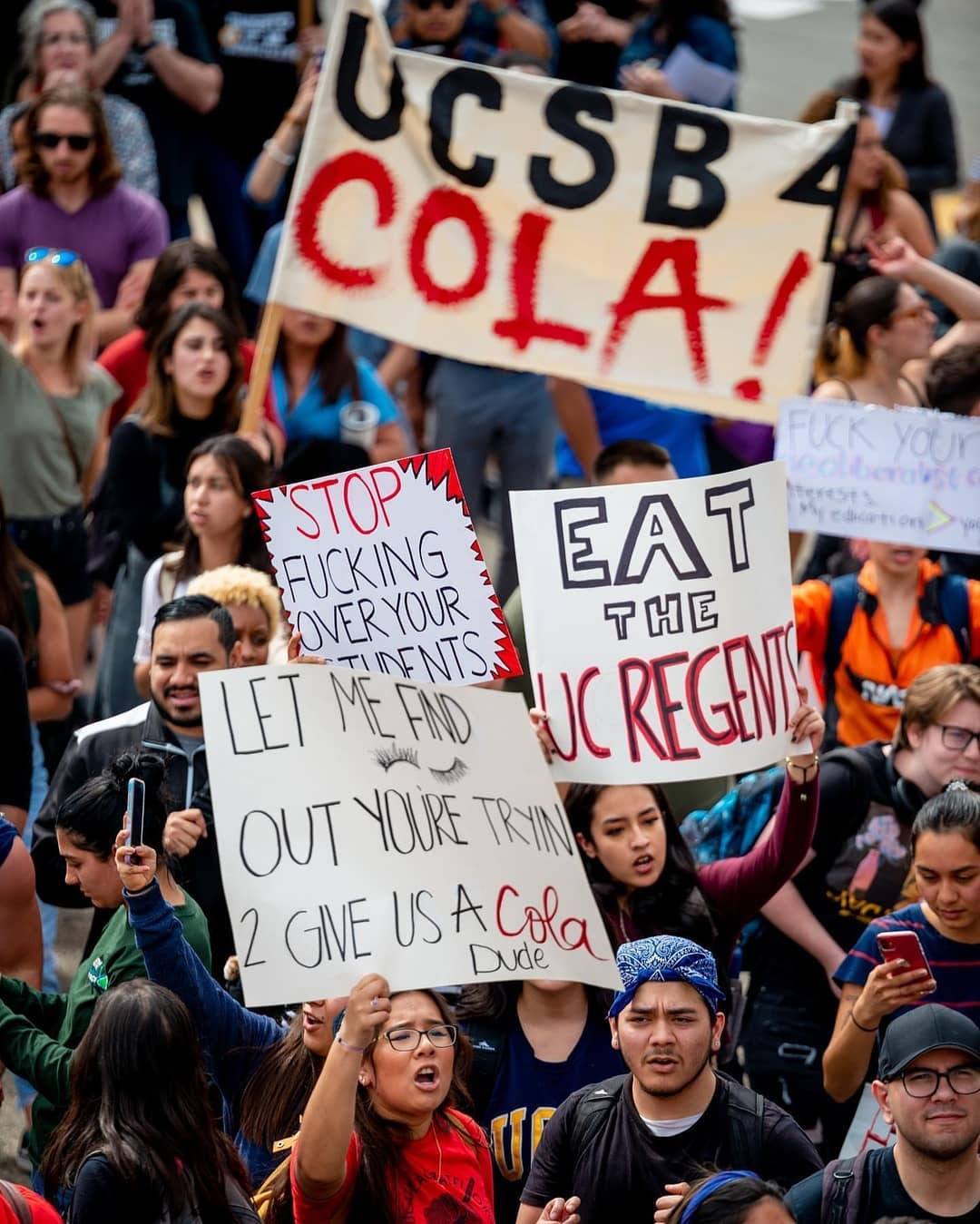
March 3: Nine UCSB students had reached day 11 of their hunger strike for an Ethnic Studies requirement. At this point in their protest, Chancellor Barbara Uehling still had not complied and avoided answering their demands. Faculty started to show up for the students, calling on their fellow faculty members to cancel classes in order to educate the students on what an ethnicity requirement would look like and how to support their fasting classmates. The students also received a letter of support from Cesar Chavez, the president of United Farm Workers of America.
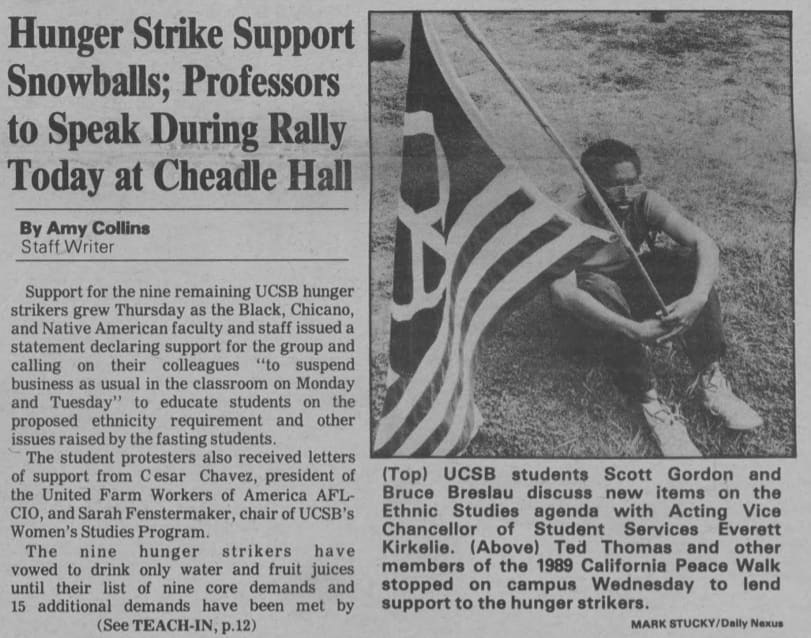
March 10: The very first Women of Color Conference was held at the Multicultural Center. It was organized by Akanke, an African-American women’s support group, Hillel, La Familia de Colores, M.U.J.E.R., S.C.O.R.E., and Womxn’s Commission. The day consisted of workshops, lectures, group discussions, performances, and it ended with a screening of “Daughters of the Dust” with an appearance from the filmmaker, Julie Dash. The conference is still held at UCSB thanks to AS Womxn’s Commission. [Information Retrieved from advertisement: https://www.alexandria.ucsb.edu/downloads/z316q283w]

March 12: UCSB Students, along with other members of the Santa Barbara community, marched to protest against Prop 22, a bill that would legally define marriage as the union between man and woman only. The participants held a candlelight vigil at the Unitarian Society Church and listened to speakers as well as watch a gay, lesbian, and heterosexual couple renew their vows. The keynote speaker, Chérie Carter-Scott, said that “the candle brings light to darkness; the darkness is bigotry, hate and derisiveness. The whole purpose of tonight’s event is to honor people, to celebrate love in all forms.”

March 31: Welcome to Spring Quarter! As we transition to remote instruction, the LHP team is dedicated to making research accessible for our members and community. Please stay connected in the near future to learn more about how you can get involved!
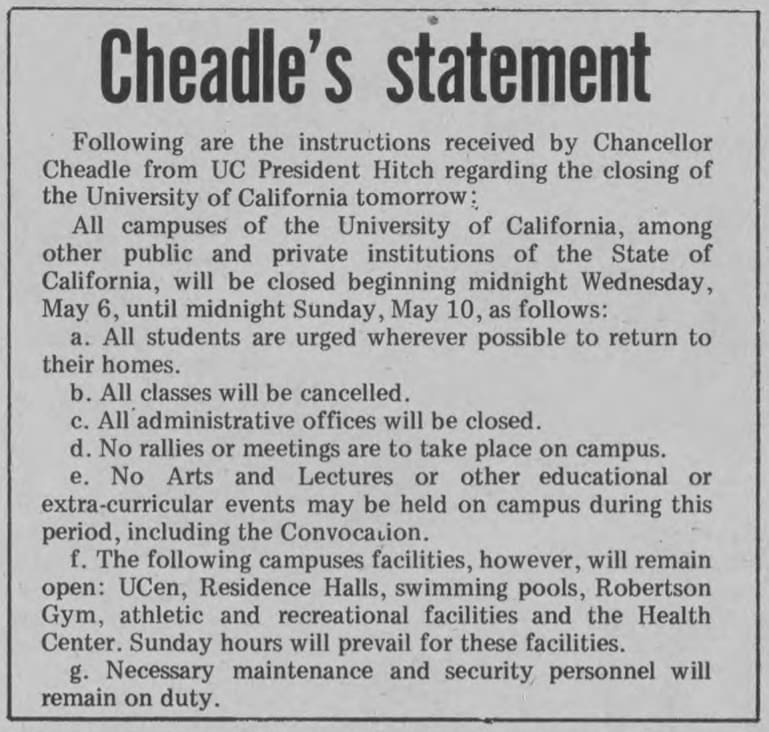
April 3: The St. Athanasius Church owned the land that Perfect Park in Isla Vista resides on and decided to move forward with the blacktopping of the park for a 61 space parking lot for the Church. Isla Vista residents were upset by this decision because this park was one of the last public spaces in IV and has historical significance as the site where many anti-war protests began in the 70s. The Church reasoned that because they owned the land they reserved the right to do what they please with it. Additionally, they argued that this would lead to further development of IV as a community. Protesters, both students and community residents, gathered at Perfect Park on the day construction was scheduled. The construction company initially responded with aggression, ripping the “i” in “Isla Vista” off of one protester’s sign. They then called the police who ushered the people out of the park, but two people, Robert Puddicombe and Scott Wexler, refused to leave. Puddicombe was quoted saying: “’ve been standing on this land for 20 some years and as far as I’m concerned, it belongs to the people of Isla Vista.” Both protesters were then arrested. Perfect Park remains a vital part of Isla Vista located at the corner of Trigo and Embarcadero del Norte. There now exists a Peace Monument in honor of the previous peace activism that happened there.
[Hornberger, Charles. (May 2, 1990). Park Construction Draws Protest: Two Arrested in Attempt to Delay the Blacktopping of Perfect Park. 𝘋𝘢𝘪𝘭𝘺 𝘕𝘦𝘹𝘶𝘴. Retrieved from https://www.alexandria.ucsb.edu/downloads/6108vc43r]
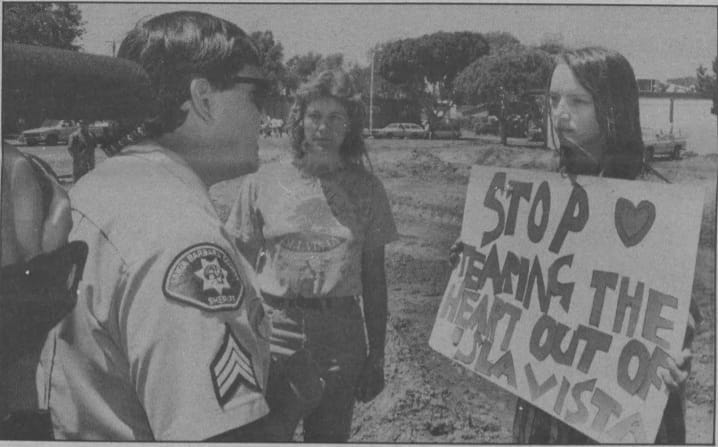
April 9: On Friday, April 4, 1986, 40 people were arrested at an anti-apartheid protest in Cheadle Hall. They were protesting because $2.4 billion of the university’s $6.3 billion portfolio was invested in companies with business ties in South Africa. Protests also broke out across other UC campuses, most notably UC Berkeley, where a riot broke out and 89 people were arrested. On that day, around 300 students boycotted their classes to attend teach-ins about the situations in South Africa, Angola and Central America; of that 300, 100 students marched into Cheadle Hall, led by protesters carrying a mock coffin. They hung banners up on the walls, sang songs of protest, chained themselves together, handed flowers to the police officers and stripped nude. They were given 6 verbal warnings, and then each protester was individually asked if they would leave the premises and those who refused were arrested. They were escorted to a bus with barred windows; students who opted out of arrest placed flowers in between the bars. Their act of civil disobedience was inspired by Nelson Mandela and his pacifist teachings. The UC Regents eventually decided to divest from South Africa.
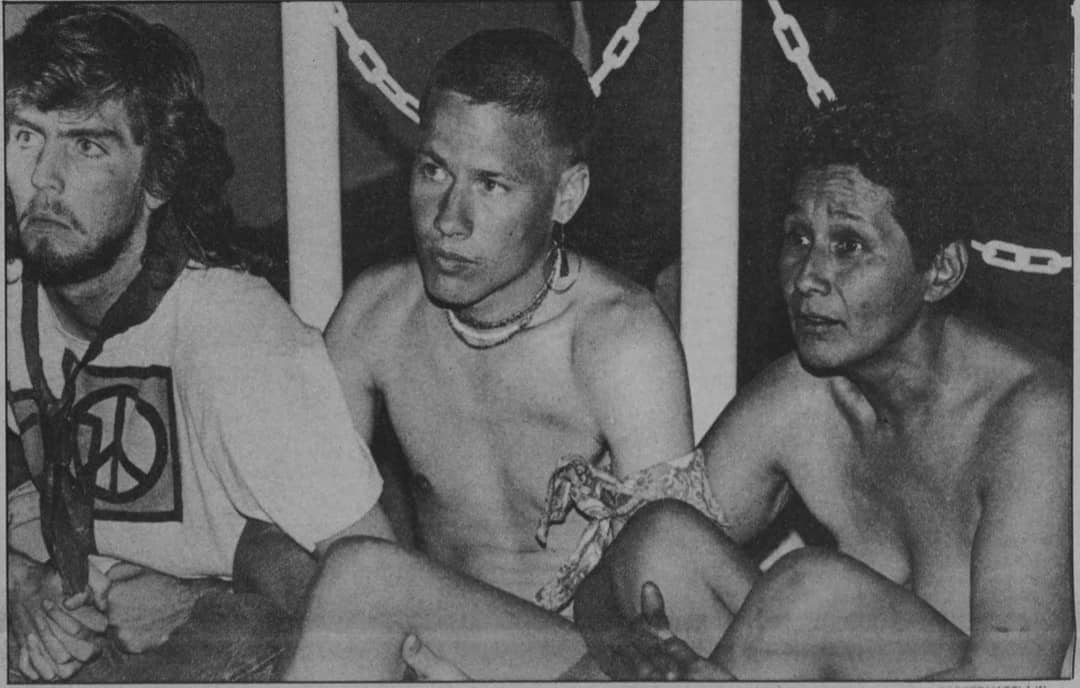
April 14: On the week of April 14-18, 1997, Take Back the Night held a Sexual Violence Awareness Week that consisted of art exhibits, colloquiums, rallies and other various events. On the last day, Friday 18, 1997, the group held a vigil against sexual assault at Storke Plaza. The evening started with performances by local IV band, Daughter, and the UCSB Dance Team. Interspersed between the performances were speeches by staff, faculty and students alike. The co-chairs of Queer Student Union, Erin O’Brien and Felicia Perez, stressed the importance of understanding that rape can happen to anyone, not just straight, white women. After the speeches, a group of over 100 students marched into Isla Vista, chanting and holding lit candles. Some people disagreed with their approach, claiming that they should not blame all men, even when some of the survivors that told their stories were men. Most people were very supportive of their movement, commending their bravery to speak out against the rampant rape culture in Isla Vista. Take Back the Night is still a vital part of the UCSB campus and you can follow them on Instagram @ucsbtbtn to stay up to date with their upcoming events!
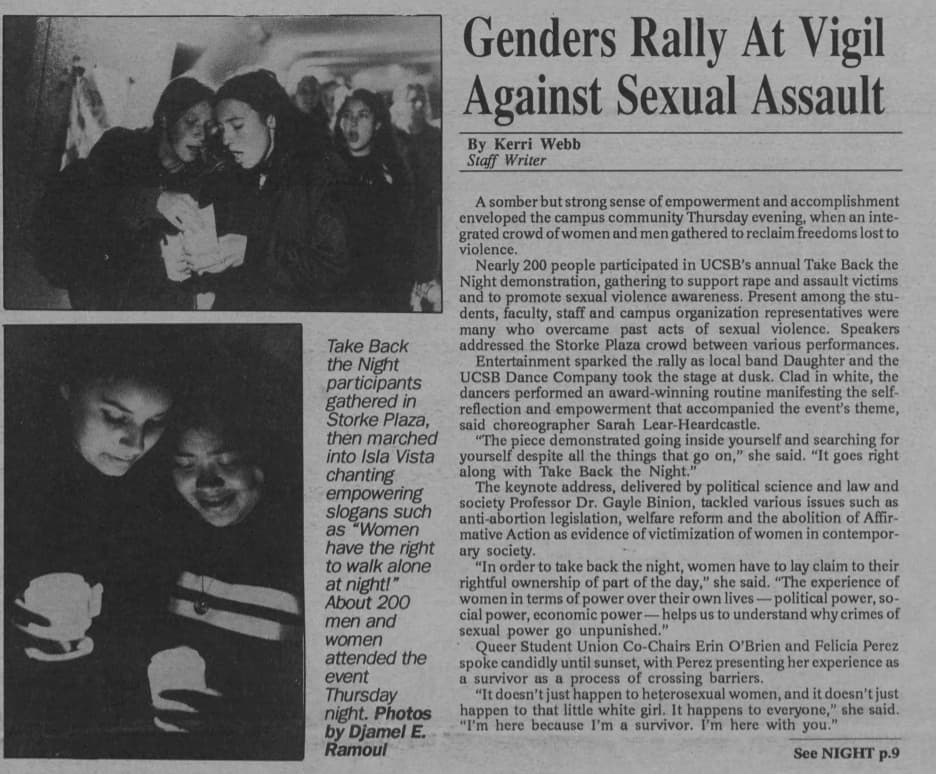
April 16: As our team prepared to move remotely, we were able to retrieve some archived pieces that we are working on eventually digitizing for general public use in the future. These images and information come from these primary documents. –


April 24 (continued from last post):


May 5: Around 75 people marched from the UCen to Santa Cruz Hall in a silent vigil against sexist activity from its residents. They walked through without engaging with residents who threw insults and provoking inquiries their way. One of the halls, dubbed BOHICA hall (BOHICA standing for: ‘Bend Over, Here It Comes Again), was producing a t-shirt many students found to be sexist. It depicted a “demon perched atop a keg of beer, with a whip in one hand, a bottle in the other, and a bikini-clad woman on her hands and knees in front of him. Emblazoned on the design is the inscription: “Man’s Best Friends.”” The protesters, both men and women, were upset with how these students not only were producing the shirt, but also how aggressively they defended its existence. In an opinion piece submitted to the Daily Nexus, one of the protesters heard accounts of men referring to the crowd with phrases such as: “We oughta B.A. these bitches,” “look at the hate in those bitches’ eyes,” and one instance of a woman saying “this is sick, this is so stupid.” The designer of the shirt claimed that he was neutral on its existence and whether or not it would not get printed. It was being produced through an unknown group in LA because the original printer backed out when San Rafael Hall refused to get their shirts printed there if the printers went through with the BOHICA design. The main disagreement stemmed between the right to freedom of expression vs. treating women with respect.

May 12: In the midst of the Vietnam War protests, students were unafraid to face off with the police, as demonstrated by the actions that happened on May 9, 1972. What started as a peaceful protest at the Santa Barbara Municipal Airport quickly escalated as police continued to exert force against these demonstrators. The police threatened to arrest the 2000 demonstrators if they failed to leave the airport by 9:30 PM. The group complied, and they voted to move the demonstration to shut down Highway 101. The airport was empty by 9:31 PM. 75 policemen in riot gear started set up barriers to the freeway at the Los Carneros overpass. The demonstrators voted to not face the police and headed back towards IV to avoid them. They had assumed the police would start to disperse when they left, but instead, police cars turned their sirens on and trailed the crowd close from behind. Someone threw a rock at one of the cars which prompted the police to get out of their cars to chase down the fleeing crowd. Witnesses claimed that there were screams from people getting clubbed by officers and police cars were driving into the crowd. Around 800 people reconvened in Perfect Park to march on ROTC but were greeted by 15 police in riot gear and were followed from behind by 2 buses full of officers; they had set a trap. Demonstrators threw rocks into the ROTC office and ripped their screens down as they ran back to IV. By midnight, there were dumpster fires on every street as ~700 protesters voted to move toward the police line again. As they walked toward Pardall Tunnel, they were met with multiple cans of tear gas and pepper gas which flooded the Loop. As folks were escaping the gas, 12 police cars were driving through the Loop at speeds up to 40 mph. They started to arrest people at 1 AM, and most of the streets were empty by 1:40 AM. The night resulted in 13 arrests, smashed windows in IV businesses, and someone falling from a 3 story building.
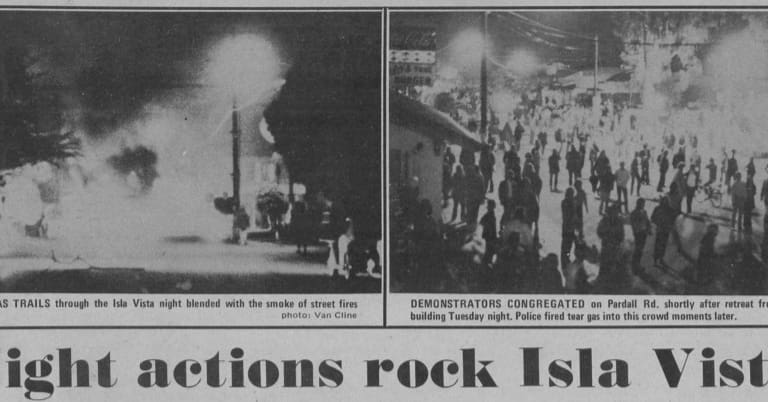
May 26: Several student groups, including Incite Insight Magazine and UCSB Grads Mobilize, came together a year after the tragic shooting in IV to publish a special edition of their magazine in remembrance of the students who lost their lives and lessons the community has learned. The zine includes tributes to the six students, poems and essays that analyze the culture of entitlement and misogyny. Many students were upset with the media for sensationalizing the tragedy and not being sensitive of the community’s need for space and healing. This zine gave voices to the students who needed to express their pain. Here is an excerpt from Shari Sanders’s, a PhD candidate, piece entitled: “I Remember Isla Vista and I Am Asking”:⠀⠀⠀⠀⠀⠀⠀

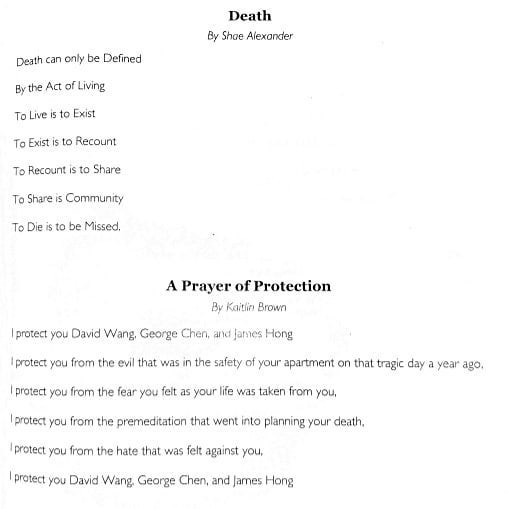
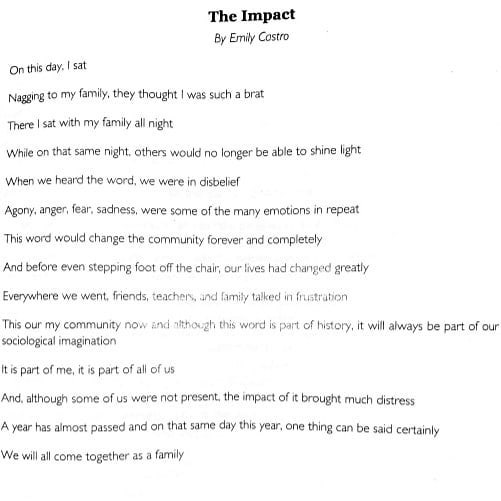

June 2: This past weekend, students and community members mobilized together to march in honor of George Floyd, Ahmaud Arbery, Breonna Taylor and countless other Black lives taken by police brutality. Black students organized a march from Storke Tower to Sands Beach on Saturday, May 30th. This work must be respected as the labor of Black students. Black voices and experiences at the UCSB campus were amplified as almost a thousand allies stood in silence to listen. Many expressed frustration at the silence of their peers in Isla Vista, who continue to party in the midst of such tragic times. The march down Del Playa was met with many bystander students, partying and staring from their balconies, but the group continued to march on. The only response from UCSB administration came during the protest and only referenced CAPS as a resource. The next day, Sunday, May 31st, the Santa Barbara community came together at the Santa Barbara Courthouse for a protest organized by Black organizers. Speakers called for Santa Barbara to acknowledge Black existence and contributions they have given the community and also for solidarity from non-Black allies. The group then marched down State Street to the Santa Barbara Police Department where they presented their demands. Their demands include institutional support for a Juneteenth celebration, preservation of historical Black landmarks, transparency and accountability from the SB Sheriff and police department, for City Council to draft a resolution for police brutality and to acknowledge racism as a public health emergency (more details can be found @juneteenthsb). When met with silence from the police and the mayor, Black protesters laid on the ground and the rest of the group knelt for 8 minutes and 46 seconds, the amount of time that George Floyd was on the ground. Follow @juneteenthsb, @blackatsb and @ucsbscore for relevant updates from Black voices. [First image retrieved from the Daily Nexus, Second image from Reddit]

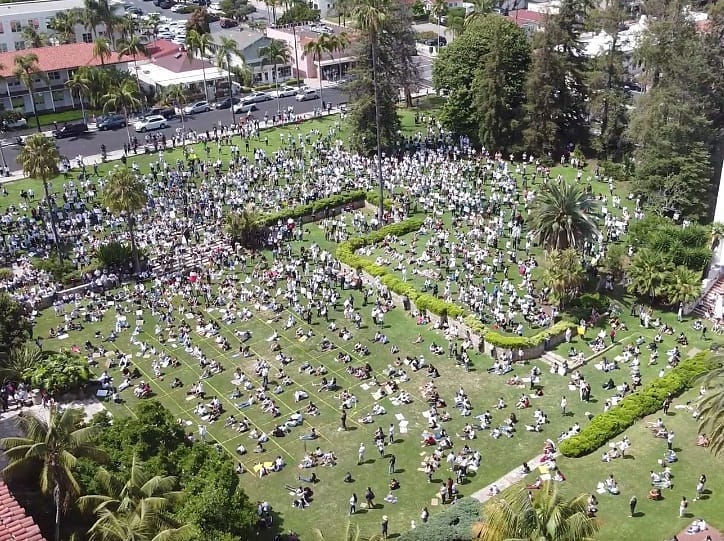
June 9: On Sunday, June 7, 2020, hundreds of members of the Isla Vista community gathered together at Sea Lookout Park for a vigil in remembrance of all those who have lost their lives to police brutality. The Black organizers handed out candles, or attendees brought their own, and the group was led on a silent, candlelight walk around Isla Vista. This was a space to remember and honor those lives that were lost, including George Floyd, Breonna Taylor, Tony McDade, Ahmaud Arbery and countless other Black lives. Once the group returned to the park, the rest of the night was spent lending ears to the speakers. Black students and community members shared their stories of grief, pain and frustration as the group listened intently. Some shared their personal interactions with law enforcement, some expressed how tired they were and others gave advice on how non-Black allies can be genuinely helpful. As the night came to a close, folks were invited to place their candles, flowers and signs at the memorial and write notes of solidarity. The memorial still stands at Sea Lookout Park and remains untouched.


June 19:

June 26: International Pride Month may be in June, but UCSB students typically organize it to be in April. Here are some images of Pride Week at UCSB throughout the years. A tradition that the Queer Student Union would do was hold a Queer Wedding on the last day at Storke Plaza. This was a way for them to protest Prop 22, a proposition passed in 2000 that defined marriage as between man and woman, and also increase visibility of LGBTQ relationships on campus. Queer Pride Week was an opportunity to educate heterosexual peers on LGBTQ+ issues and experiences as well as an opportunity for the LGBTQ+ community at UCSB to celebrate their existence. The week typically consists of workshops, panels, screenings and drag performances.
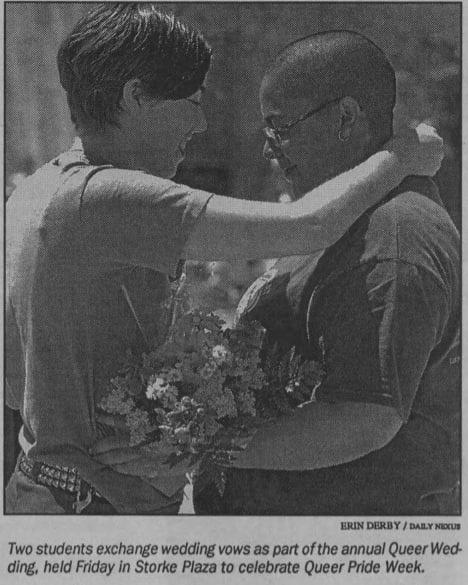
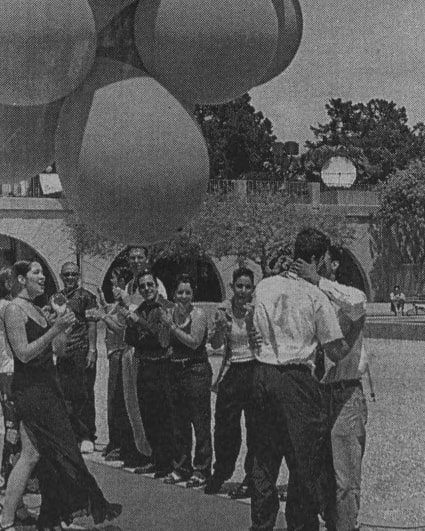
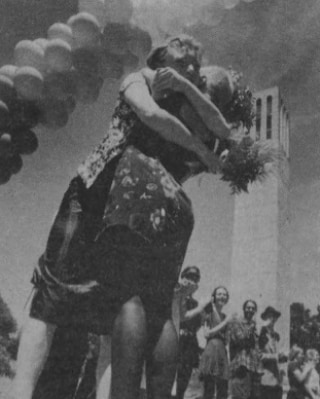


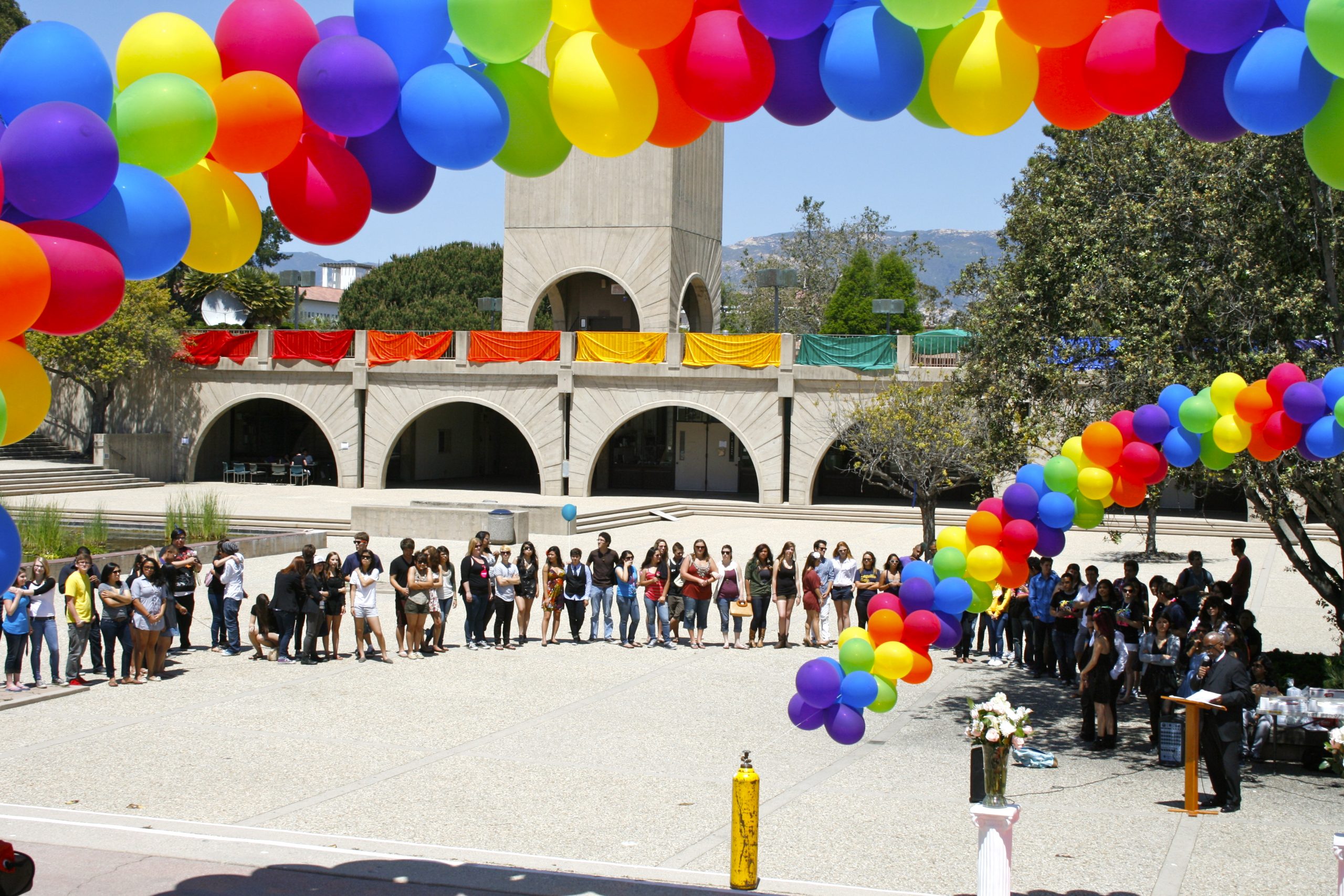
Ending the year and by way of summing up.
July 9: During Spring Quarter, our researchers put together an extensive timeline of what graduate student organizing looked like throughout UCSB’s campus history. Starting in 1984 and spanning all the way to the COLA movement, they read articles, primary documents and even interviewed people; those interviews can be found under our oral history section. Our researchers quickly adapted their research methods during the pandemic, but that did not stop them from pursuing this much needed work. Let’s celebrate their hard work!

